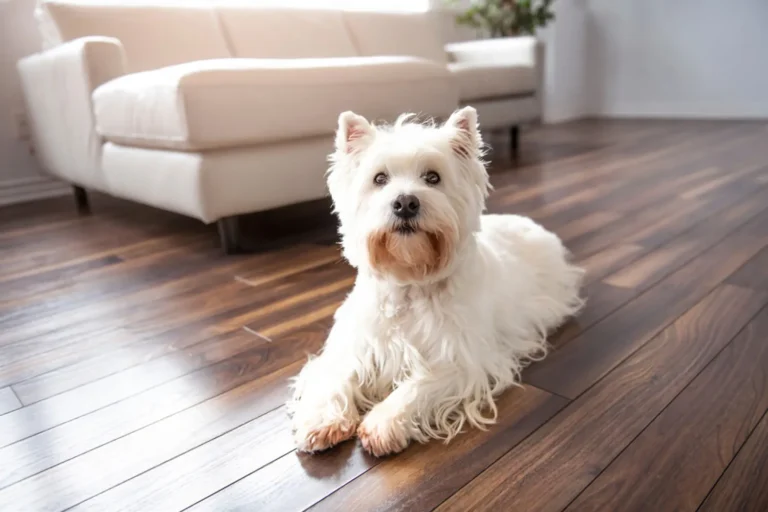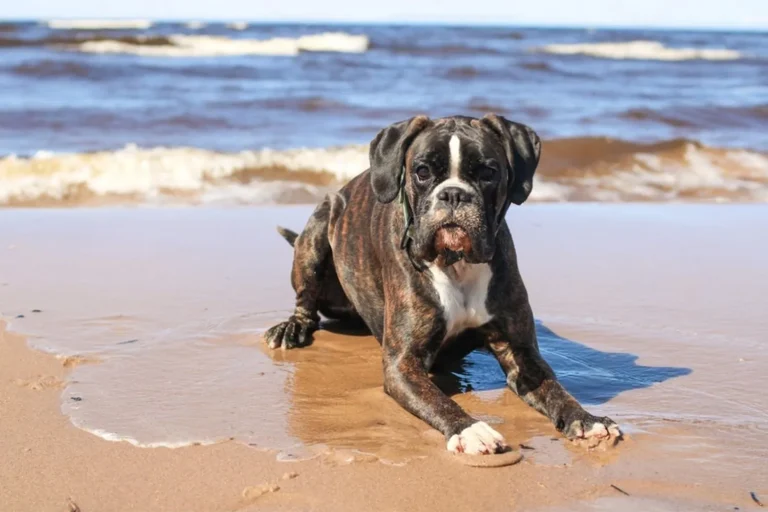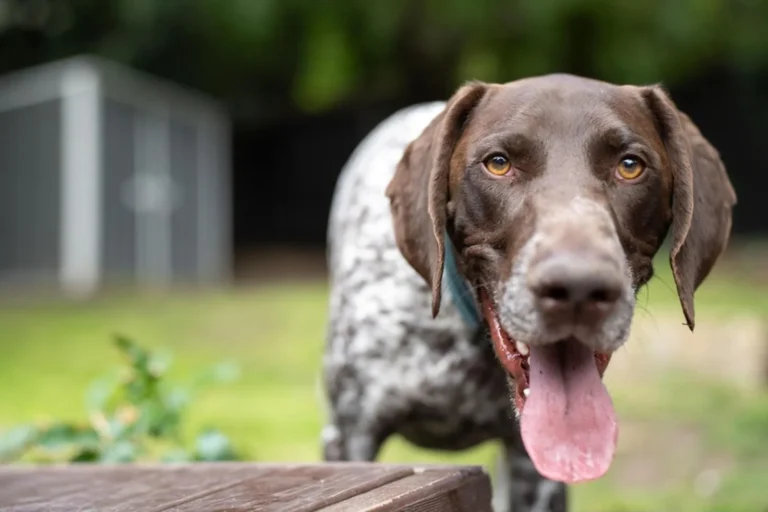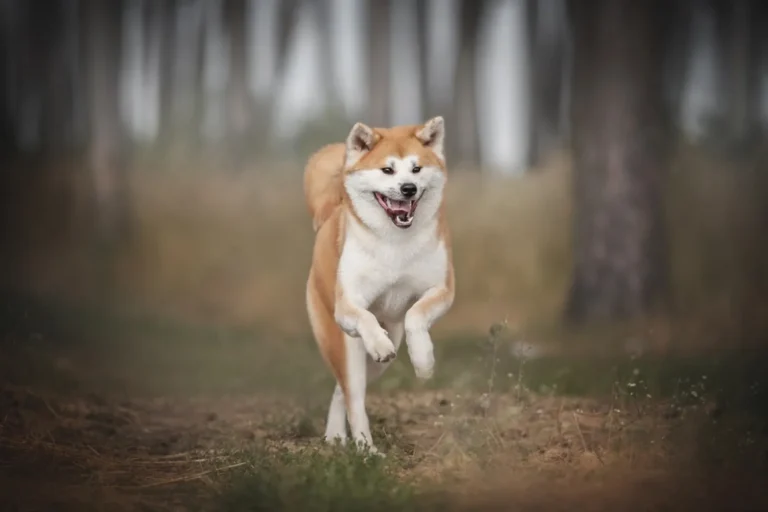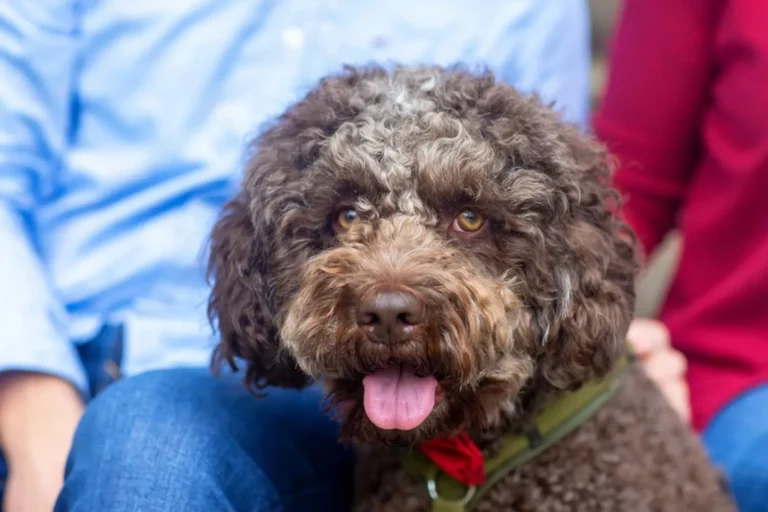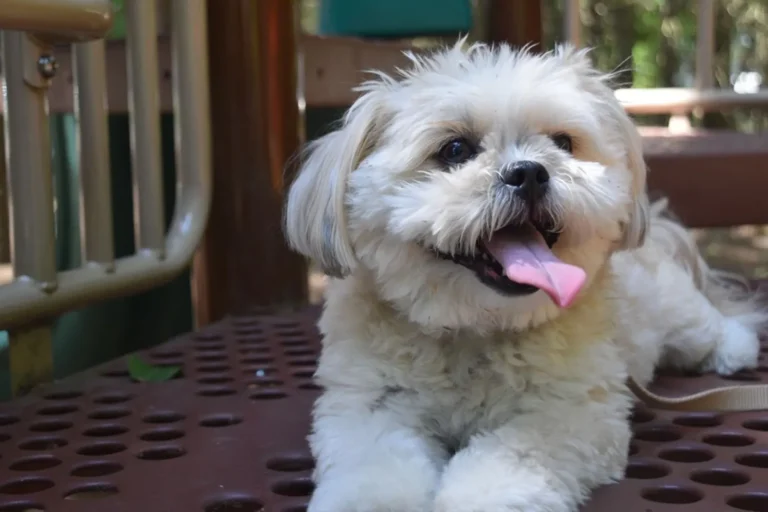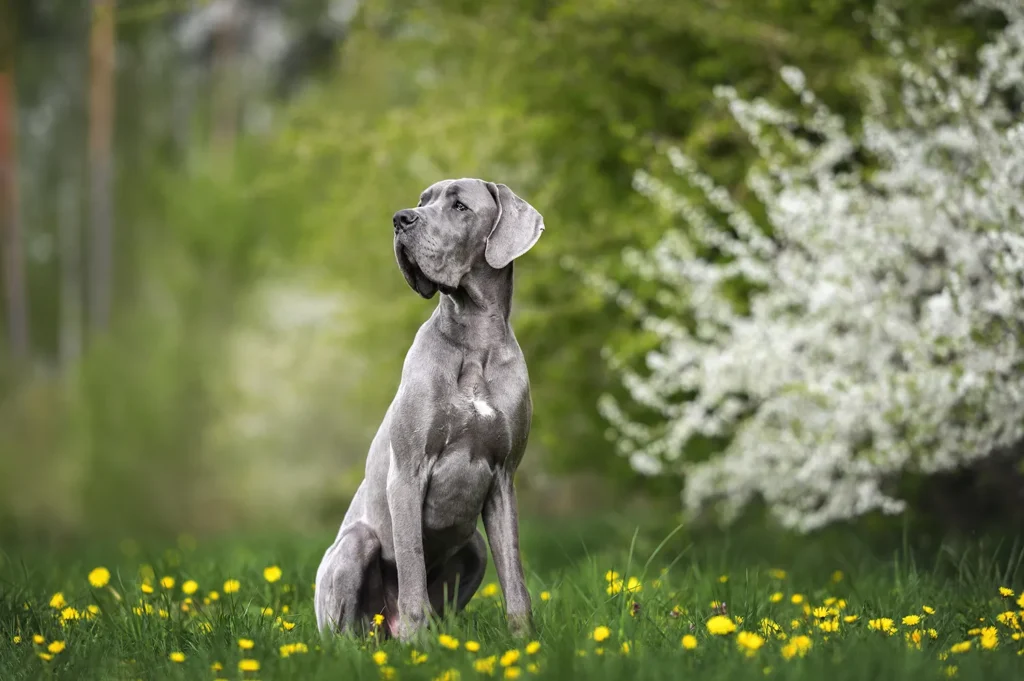
If you’re going big, you might as well go grand with a Great Dane a gentle giant with a couch sized heart. I once dog sat a Dane named Moose who leaned against me like a weighted blanket and followed me from room to room as if he were on security detail. Despite their size, most Danes are sweet, calm companions who just want to be near their people.
A few friendly tips: make peace with drool and clear space for that swooshy tail. Start training early (a polite “sit” is golden when your dog is eye level with the countertop). Plan for a sturdy bed, daily but not extreme exercise, and a realistic food budget. Ask your vet about a feeding routine that supports a happy tummy. In return, you’ll get a loyal shadow who thinks he’s a lapdog and honestly, it’s adorable.
History and Origin of the Great Dane
Despite the name, the Great Dane isn’t Danish at all. Their story begins in Germany, where breeders blended the power of English Mastiffs with the height and speed of Irish Wolfhounds. By the early 17th century, these big, athletic dogs were prized by European nobles as formidable hunting companions fast enough to keep up, tall enough to see over brush, and brave enough to face down serious game.
Their specialty was wild boar, with some hunts also targeting bears and deer. Before firearms were commonly used, Danes were tasked with a nerve wracking job: rush in, seize, and hold the animal long enough for the hunter to finish the job. Imagine the courage that took. A friend of mine who owns a Dane jokes that her dog “leans on problems until they give up” which is exactly the kind of steady, unflappable temperament early hunters valued. That steadiness still shows today when a skateboard rattles by and a well trained Dane simply watches, ears perked, instead of exploding into chaos.
The name has taken quite a journey too. In Germany, they were first known as Englische Dogge, a nod to their English Mastiff roots. In 1878, breeders officially renamed them Deutsche Dogge, which many German speakers and some kennel clubs still use today. The “Great Dane” label actually came from the French term Grand Danois great Danish dog even though Denmark had nothing to do with their development. I once met a Danish tourist at a dog park who laughed and said, “We don’t deserve credit for that masterpiece!” If someone asks whether your Dane is Danish, it’s a fun excuse to share the real history.
As big game hunting faded, these dogs found a new role as estate guardians and, eventually, beloved family companions. A breeder I spoke with in California told me they’ve long selected for gentleness alongside size, which is why so many Danes are mellow couch buddies at home. Still, that hunting heritage means they thrive with confident training, room to stretch those long legs, and a job to do even if the job is just accompanying you on a brisk morning walk and then supervising the couch for the rest of the day.
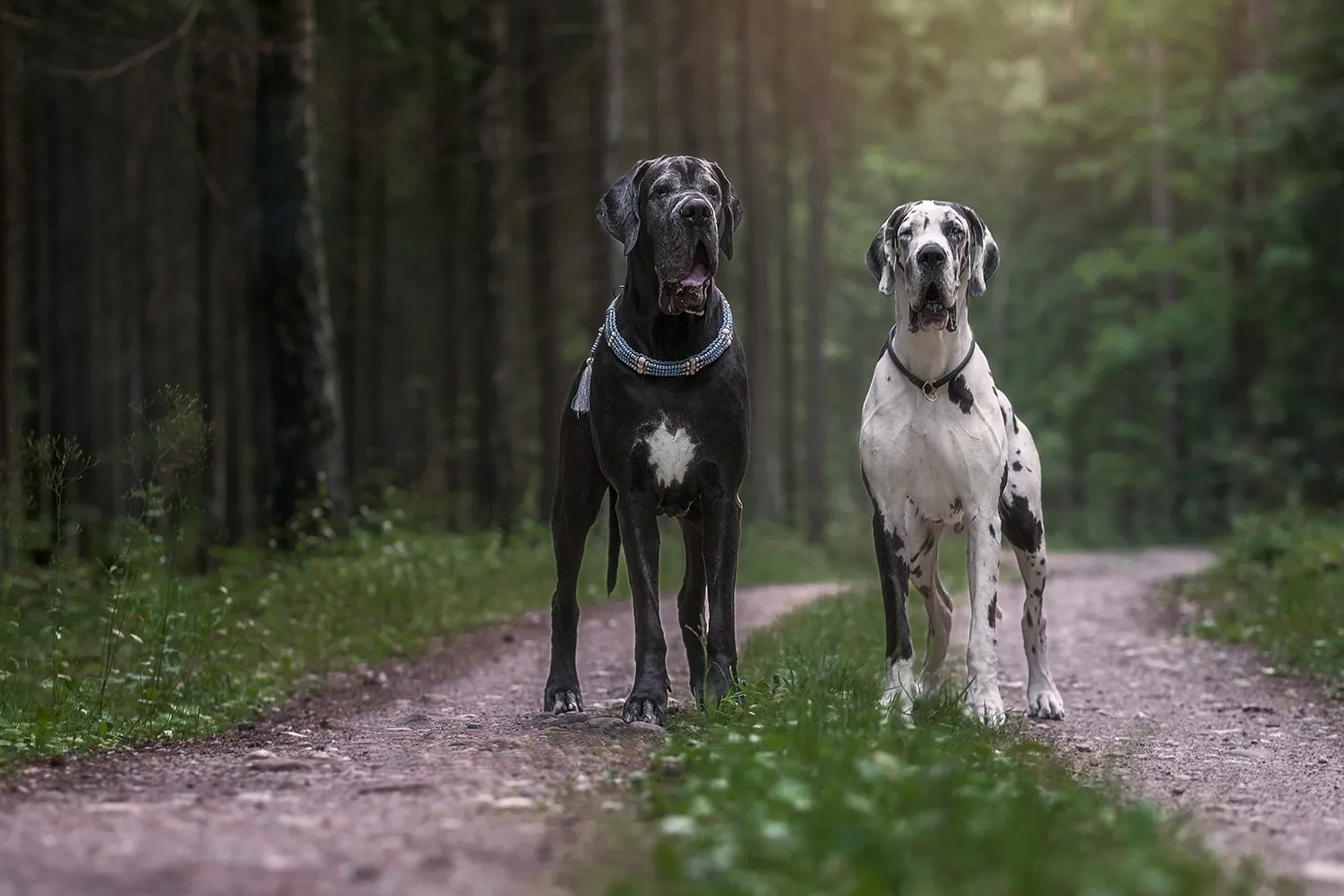
What Is a Great Dane?
Think towering legs and a heart to match. These gentle giants are as big as they come, yet they’re famously friendly, steady, and loyal. With that square, almost rectangular head and a sleek, short coat, they’re easy to spot from a mile away well, that and the way they lean into you like a warm tree. My neighbor’s Dane used to rest his whole weight against my legs during chats, and I’d have to brace like a surfer. They’re calm house companions, but because of their size, a little early training goes a long way. A polite Great Dane is pure magic; teach “off,” loose leash walking, and doorway manners sooner rather than later.
Color wise, most people picture the classic golden brown (fawn) coat very regal. But you’ll also meet Danes in inky black, tiger striped brindle, steel blue grey, striking harlequin (white with bold black patches), and the tuxedo like mantle. I once met a harlequin at the park who looked like living modern art. Grooming is simple a quick brush keeps that short coat shining but remember, big dog means bigger everything: beds, bowls, and yes, the occasional drool string. Give them soft places to nap, daily walks to stretch those long legs, and plenty of love. They’ll give it all right back.
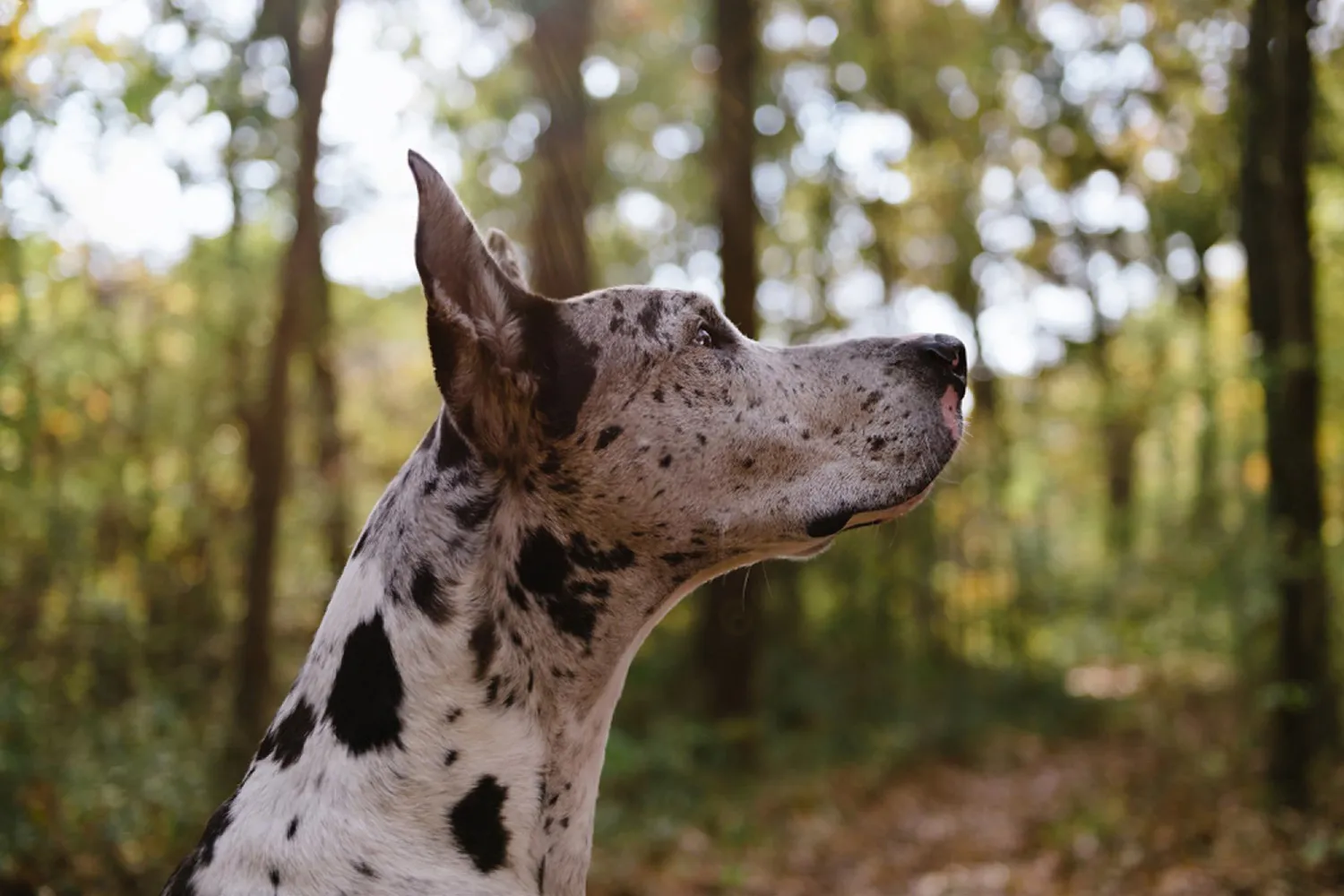
Who is a Great Dane Best For?
Despite their size, Great Danes are wonderfully gentle and surprisingly easy to live with, which is why they can be a great match for first time dog owners. They’re eager to please and pick up the basics quickly if you keep training fun and consistent. I helped my neighbor crate train her Dane puppy, Willow, and by the end of the weekend she was trotting into her crate on cue for a squeaky toy. The trick was keeping sessions short and clear these big softies thrive on simple routines and lots of praise.
They aren’t the most energetic dogs, but they still need about two hours of exercise a day, split into several outings. Think morning stroll, a midday sniffari, and a relaxed evening loop, with a bit of play in the yard. Mine loved slow, steady walks and a puzzle toy after dinner. Mental exercise helps too scatter feeding kibble or practicing “sit, wait, okay!” before meals goes a long way. After that, they’re world-class nappers who will happily drape themselves across your couch like a living throw blanket.
Because of their sheer size, Great Danes are usually better for families with older children. They’re friendly and good natured, but a happy tail can clear a coffee table in one swipe. I learned to teach “off” and “wait” early, and to park a Dane for greetings older kids can help with those cues and enjoy gentle games of fetch in the yard.
Thanks to their calm nature and the fact that they aren’t big barkers, Great Danes make excellent house dogs. If you’ve got space for a jumbo bed, a few sturdy bowls, and a stash of drool cloths by the door, you’ll have a peaceful, affectionate companion who’s perfectly content to be your oversized shadow at home.
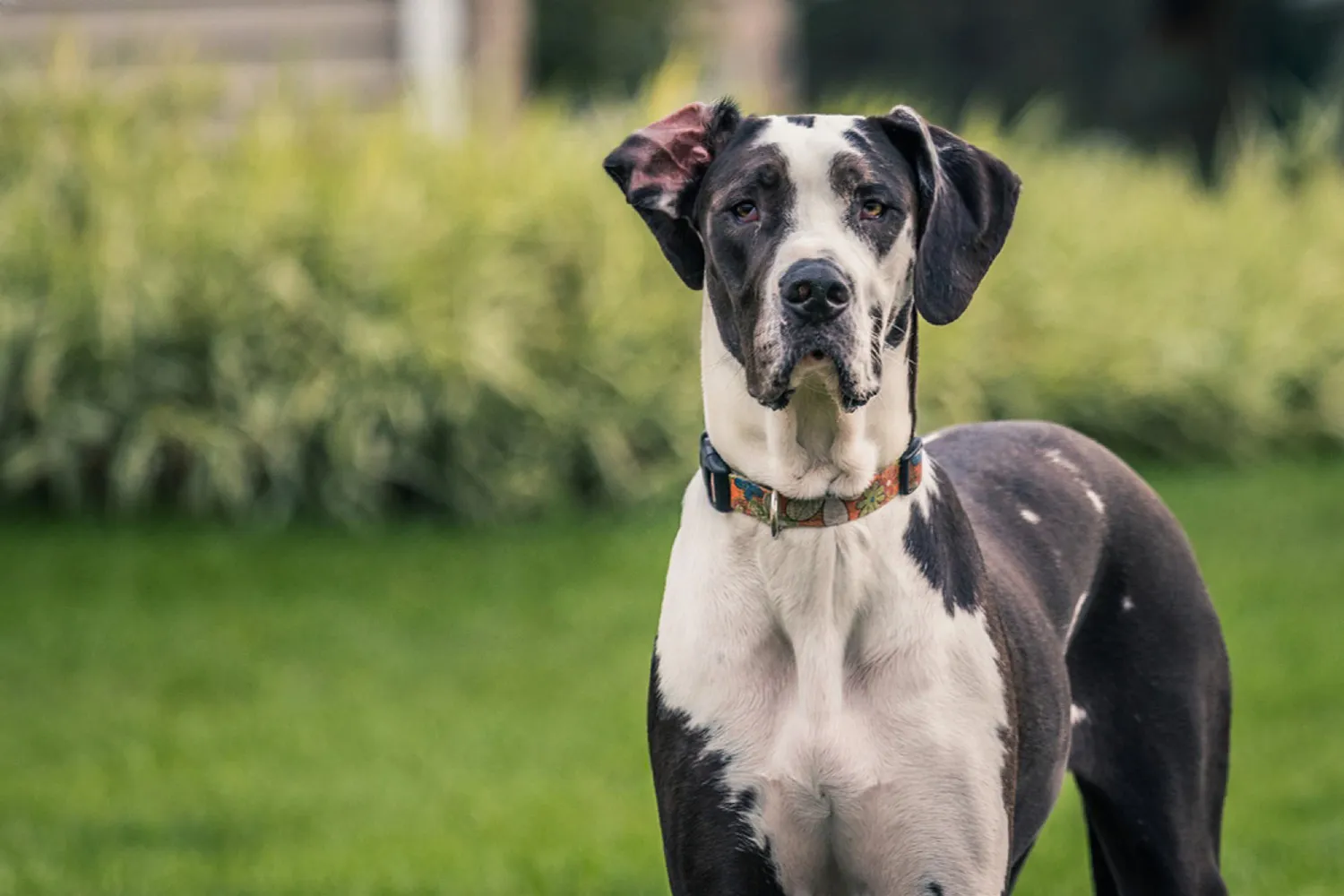
Great Dane Grooming & Shedding
For such a giant dog, a Great Dane’s coat is refreshingly simple. Their hair is short and a bit coarse, and they shed somewhere between medium and heavy. Because there’s a lot of dog, you’ll notice the hair even more those little needle like strands seem to find their way onto every pair of black jeans. They aren’t hypoallergenic, so if allergies are a concern in your home, this isn’t the best match. I always tell friends with sensitivities to meet a Dane outdoors first to see how they feel.
A quick daily brush makes a big difference. I like a rubber curry brush or grooming mitt five minutes after our evening walk, and I’ve cut my vacuuming in half. Expect a slight uptick in shedding during seasonal changes. Bathing every six to eight weeks is a good rhythm; use a gentle shampoo and rinse thoroughly (I learned the hard way that a rushed rinse equals itchiness later). A walk in shower is your friend with a dog this size one time I tried the bathtub and ended up wetter than the dog.
Grooming is otherwise low maintenance compared with many breeds: no clipping or fancy trims. Still, keep an eye on the basics. Check and wipe those big floppy ears weekly, keep nails neatly trimmed so joints don’t take a pounding, and give teeth a quick brush a few times a week. I stash a lint roller by the door and another in the car little habits that make living with a glorious, shedding giant feel easy.
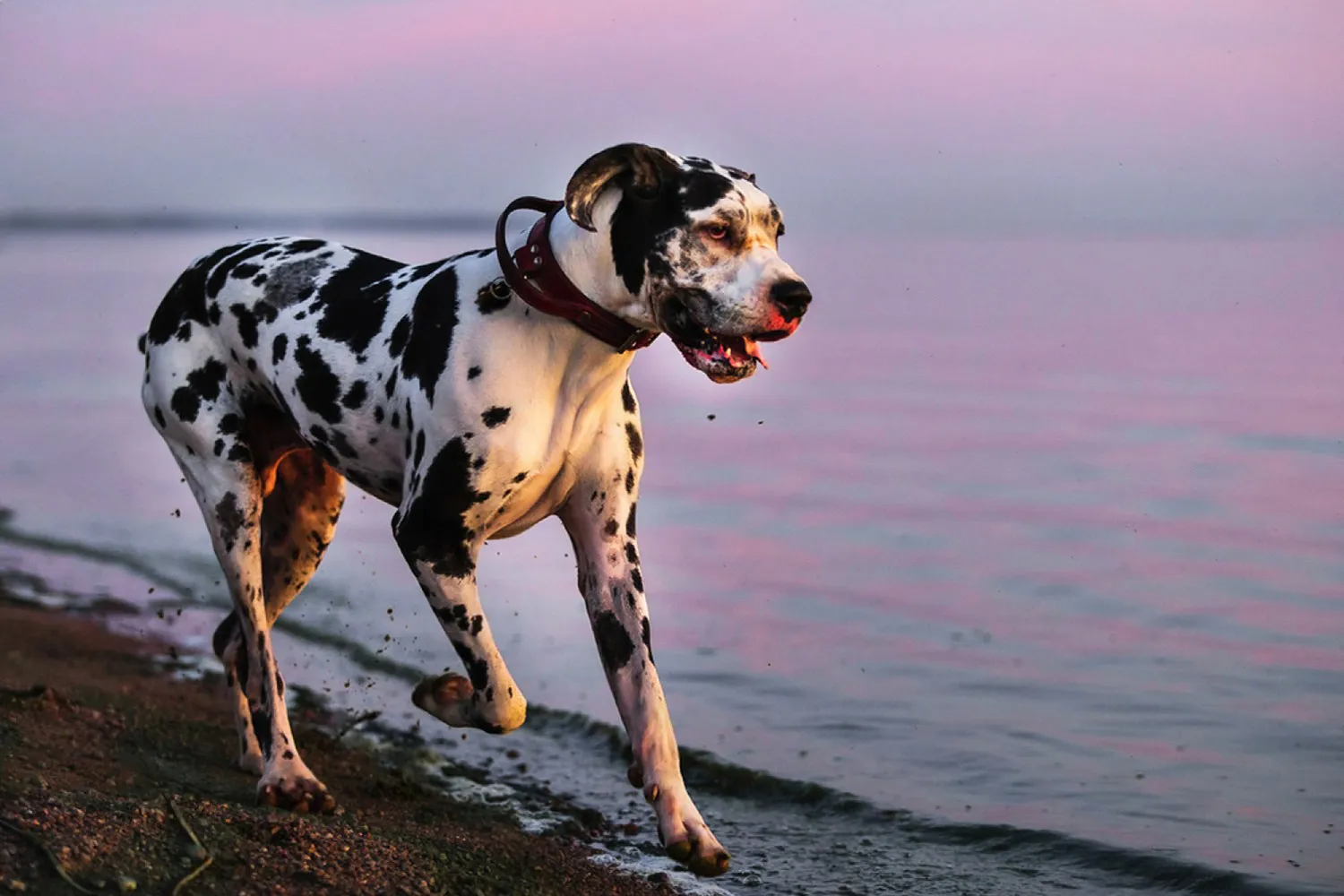
Do Great Danes bark a lot?
In my experience, most Great Danes aren’t constant barkers, but when they do speak up, you’ll definitely hear it. That deep, movie trailer voice can rattle the mail slot. How much your Dane barks really does come down to the individual dog and the training you put in. My old boy, Moose, was quiet as a mouse most days, but the doorbell, a squirrel on the fence, or the neighbor’s recycling bin rolling down the driveway could set off a short, dramatic announcement.
Barking usually has a reason: hunger, needing the toilet, wanting a walk, reacting to sounds, or spotting something out the window. I like to start by checking the basics Is it mealtime? Do we need a potty break? Have we had a good walk and a sniff around today? Danes love routine, so keeping a regular schedule for feeding, bathroom breaks, and exercise goes a long way. I even taught Moose to ring a bell by the door for potty time; it cut down on the “guessing barks” almost overnight.
Training helps, too. I teach a quiet cue by praising the moment they pause between barks, then rewarding that calm. If your Dane revs up at windows, try frosted film or closing curtains during busy times, and give them a comfy “settle spot” away from the action. Reward calm lounging like it’s an Olympic sport. For doorbell drama, I practiced with a recording ring, treat for staying on the mat, repeat. And remember, don’t accidentally reinforce demand barking; ask for a sit before opening the door, clipping the leash, or tossing the ball.
Lastly, Great Danes are big softies who don’t love being alone. A stuffed frozen Kong, a good chew, or gentle background noise can help. Start these habits young, and you’ll likely have a mostly quiet, very polite giant at your side.
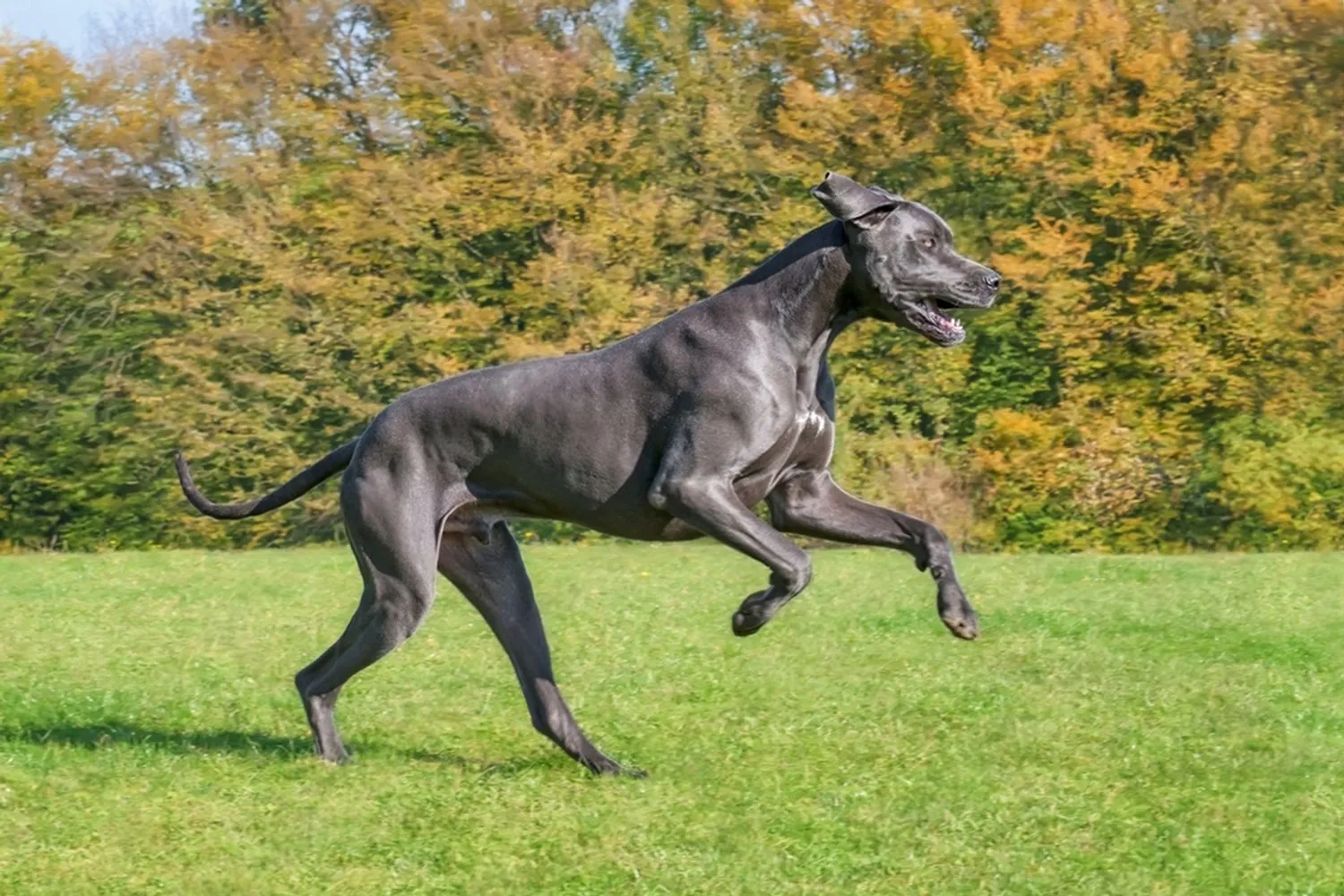
Average Height and Weight of a Great Dane
Before you fall for those goofy grins and velvet ears, it’s worth picturing just how much dog you’re inviting into your life. Great Danes are true giants, and their size affects everything from the space you’ll need to the food bill and whether you can comfortably handle them on a leash. I once rearranged my living room because my friend’s Dane, Moose, needed a wider “turning radius” between the couch and the coffee table. He still managed to clear the table with one happy tail wag.
In terms of numbers, male Great Danes typically stand about 76 to 86 cm at the shoulder and weigh roughly 63.5 to 80 kg. Females usually reach 71 to 81 cm and weigh around 50 to 63.5 kg. That height is measured at the shoulders (the withers), not the head important when you’re sizing beds, crates, and the back of your car. For a sense of scale, my neighbor’s female could rest her chin on the kitchen counter without even trying. Counter surfing is practically a sport with these guys, so a little training and a lot of tidying goes a long way. https://en.wikipedia.org/wiki/Great_Dane
Growth wise, expect a fast start. The first nine months bring the most dramatic changes in height and weight, so a healthy, nutritious diet is essential from day one. I like to keep a growth chart on the fridge nothing fancy, just monthly notes on weight and a pencil mark on the wall so I can spot sudden spurts and chat with the vet if anything seems off. Even after the big height gains slow down, they’ll keep filling out and adding muscle, reaching full maturity around 18 to 24 months.
A few practical tips from life with big dogs: start leash manners early, because teaching a 10-kg puppy not to pull is a lot easier than persuading a 70-kg teenager. Choose a sturdy harness, practice “wait” at doors, and give them soft landings no marathon stair sessions or high impact leaps while those joints are developing. And budget a little extra for quality large breed puppy food; slow, steady growth is the goal.
They’re enormous, yes, but with the right preparation and a sense of humor, a Great Dane’s size turns from challenge to charm. Just make peace with the fact that you may never sit alone on the couch again.
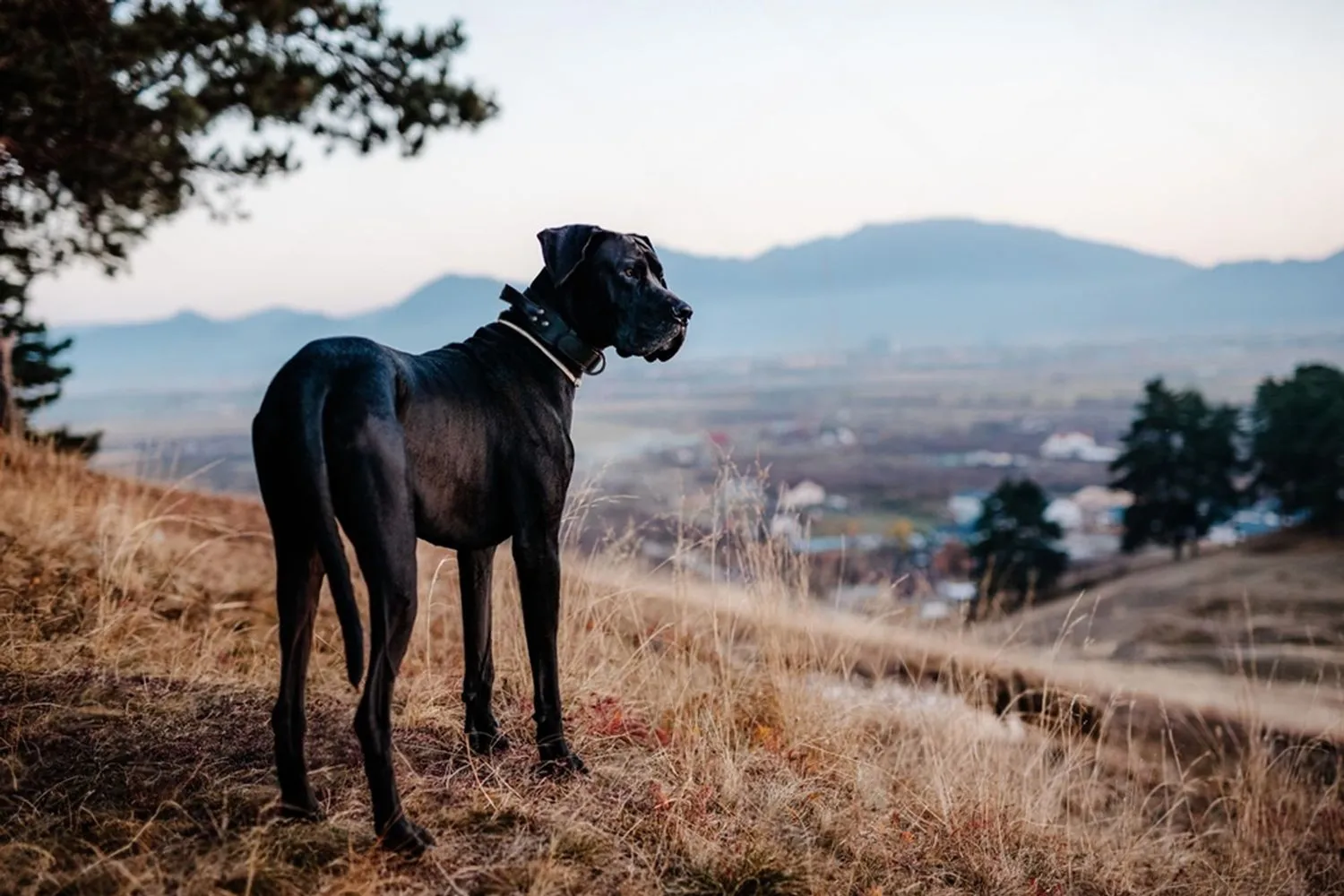
Are Great Danes easy to train?
Short answer: yes especially if you start early and keep things simple and positive. Great Danes sit in that sweet spot of medium intelligence, which actually works in your favor. They’re smart enough to learn quickly, but they don’t need constant brain games to stay focused like some super high octane breeds. I always joke that my Dane didn’t try to outsmart me; he just wanted to understand the rules and make me happy.
Most Danes are eager to please, fairly obedient, and surprisingly fast at picking up new cues. When my friend brought home her Great Dane puppy, they had “sit,” “watch me,” and “wait” at the door down in a week. The difference maker? Tiny, frequent sessions-5 to 10 minutes, a few times a day with treats and a cheerful tone. Consistency is everything. Start from day one with the basics: sit, down, come, leave it, and polite leash walking. And because they grow fast, teach good manners early no jumping on people, no pulling, and no counter surfing. It’s a lot easier to practice loose leash walking in the hallway now than to negotiate with 140 pounds later.
If you’re bringing home an older Dane, don’t worry they can still learn beautifully. You’ll just need a bit more patience and routine. Keep sessions upbeat, avoid lots of jumping or harsh corrections (those big joints are still delicate, even in young adults), and add daily socialization. Do that, and your gentle giant will be a well mannered companion before you know it.
How Do Great Danes Behave? A Look at Their Temperament and Personality
Great Danes are the definition of gentle giants. Most are mild mannered, sweet, and surprisingly easy going for their size. They tend to get along beautifully with people and other animals, often preferring to lean gently against your leg like a living, oversized weighted blanket. I once dog sat a Dane named Moose who believed he was a lapdog; he’d fold himself onto the couch beside me with the kind of sigh that says, “This is my spot now.”
Despite their soft nature, remember that everything a Great Dane does is… amplified. A happy tail can clear a coffee table in a single sweep, and a playful hop can bowl over a toddler without any ill intent. That’s why training isn’t optional with Danes it’s essential. Start early with the basics: sit, down, stay, and especially “wait” and “off.” I like teaching “easy” for polite walking and greeting; a well fitted harness and calm, consistent practice work wonders. These dogs are sensitive and respond best to positive reinforcement and a steady, confident voice.
Socialization matters too. Introduce them to different people, dogs, and settings while they’re young and keep it positive. Most Danes are friendly social butterflies, but like any big dog, they appreciate knowing what’s expected. A short, cheerful training session followed by a comfy nap is a very Great Dane kind of day. They’re often content to be couch companions, yet they do need daily walks and a little mental enrichment think puzzle toys or practicing a few fun tricks. One of my friend’s Danes learned to touch a target with his nose; it kept his brain busy and made vet visits easier.
Around the house, teach them polite door manners and how to settle on a mat. Supervise around small kids until everyone learns the rhythm of living with a giant. And don’t be surprised if your Dane becomes a devoted “velcro dog,” shadowing you from room to room. With gentle guidance, early training, and a sense of humor about the occasional drool string, you’ll have a calm, affectionate companion who’s as easy to love as they are big.
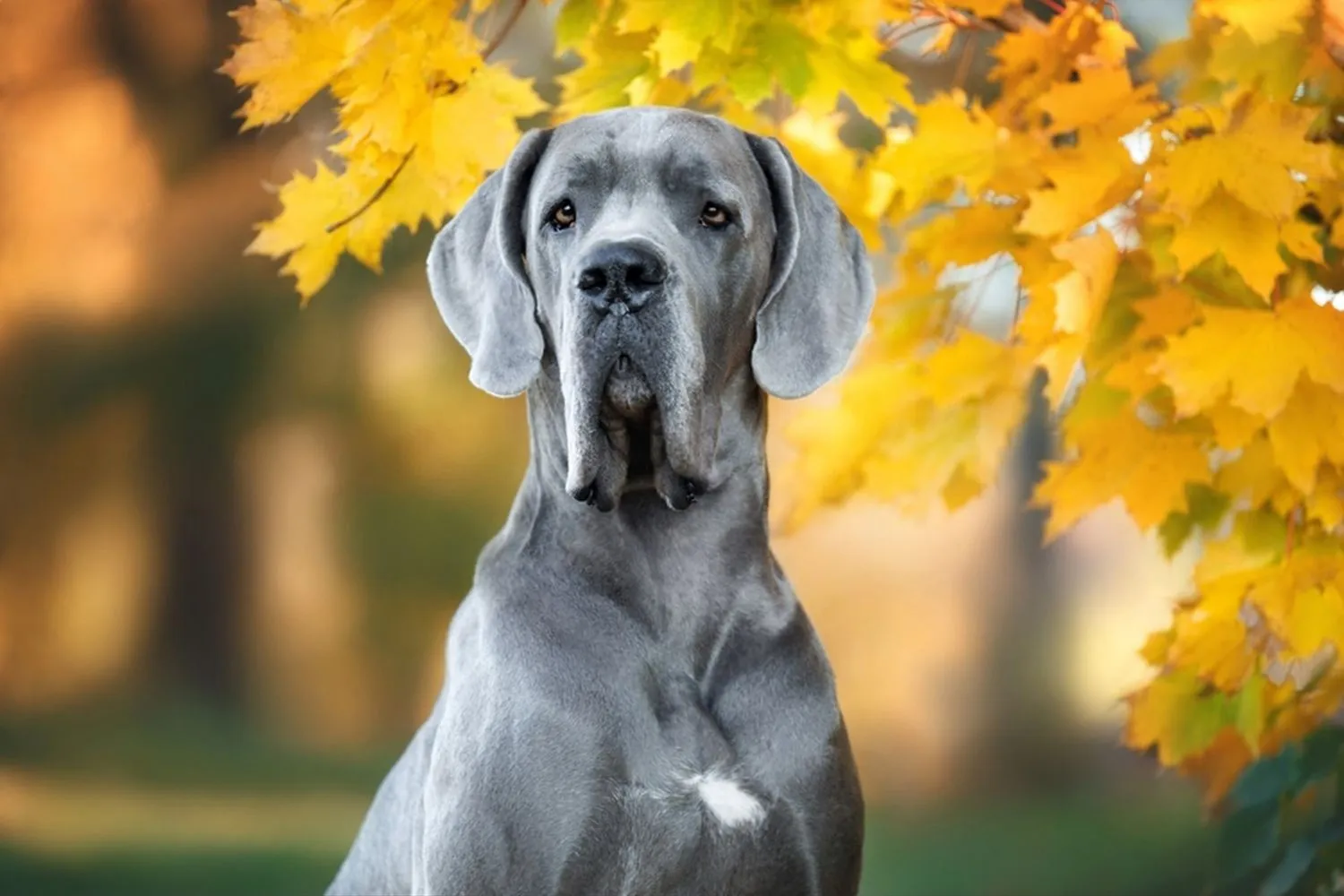
Do Great Danes Have Common Health Issues?
Big dog, big heart, and yes some big health considerations. Because of their size, Great Danes are more prone to certain issues than smaller breeds. That doesn’t mean a Dane can’t live a happy, comfortable life; it just means we have to be a little proactive. I always say Danes are like gentle sports cars: gorgeous, powerful, and worth the regular maintenance.
Joint and bone diseases are the big ones. Those long legs and fast growing bodies can lead to aches, arthritis, and mobility problems over time. I keep non slip rugs in the hallway and a giant orthopedic bed in the living room so my Dane doesn’t slip or have to heave himself up off a hard floor. If you’ve got a young Dane, ask your vet about large breed puppy food, slow and steady growth, and whether joint support supplements make sense. Keeping them lean is the best gift you can give their joints.
Hip dysplasia is part of that picture too when the hip joint doesn’t fit quite right, it can cause discomfort and early arthritis. Watch for “bunny hopping,” reluctance to jump into the car, or stiffness after naps. My friend’s Dane started hesitating on the stairs at two years old; early X rays and a tailored exercise plan kept him comfortable for years.
Danes also have a few internal issues we keep an eye on. Addison’s disease (an adrenal gland disorder) can be sneaky off and on vomiting, low energy, or just looking “blah.” Routine bloodwork and a vet who knows the breed can catch it early, and most dogs do well once treated. Thyroid problems, especially hypothyroidism, can show up as weight gain, a dull coat, or sleepy behavior. That one’s usually managed with a simple daily pill easy peasy once it’s diagnosed.
Heart health matters with Danes. Canine dilated cardiomyopathy (DCM) weakens the heart muscle, and tricuspid valve disease can cause murmurs and fluid buildup. I make a habit of asking the vet to really listen to the heart at every visit, and I watch for subtle signs like tiring quicker on walks, coughing at rest, or heavier breathing. If your vet suggests a cardiac work up or an echocardiogram, don’t panic that’s just us being thorough.
Bloat (gastric dilatation volvulus) is the emergency we all memorize. A swollen, tight belly, unproductive retching, pacing, drooling go to the ER immediately. I keep the nearest emergency clinic’s number on the fridge and in my phone, and I feed smaller, more frequent meals. A slow feeder bowl helped my gulper. Talk to your vet about a preventive gastropexy, especially if your Dane is already going in for a spay/neuter.
Osteosarcoma (bone cancer) is, sadly, more common in giant breeds. A sudden, persistent limp or a firm swelling on a leg is a “call the vet today” sign. Treatment can be aggressive, but catching it early gives you more options and, importantly, better pain control.
Here’s my quick care checklist after years with big dogs:
– Keep them slim and strong; gentle walks and low impact play beat high jumps and hard sprints.
– Use ramps for cars and beds, and keep nails short.
– Schedule regular vet visits; I moved to twice yearly checkups once my Dane hit middle age.
– Learn your dog’s normal: appetite, energy, breathing while asleep. Changes are clues.
– Consider pet insurance early it’s a lifesaver with giant breeds.
Great Danes are glorious goofballs who give back tenfold. With a little planning and a good relationship with your vet, you can stay ahead of the common issues and keep your big buddy lounging on the couch, draped like a horse blanket across your legs just how they like it.
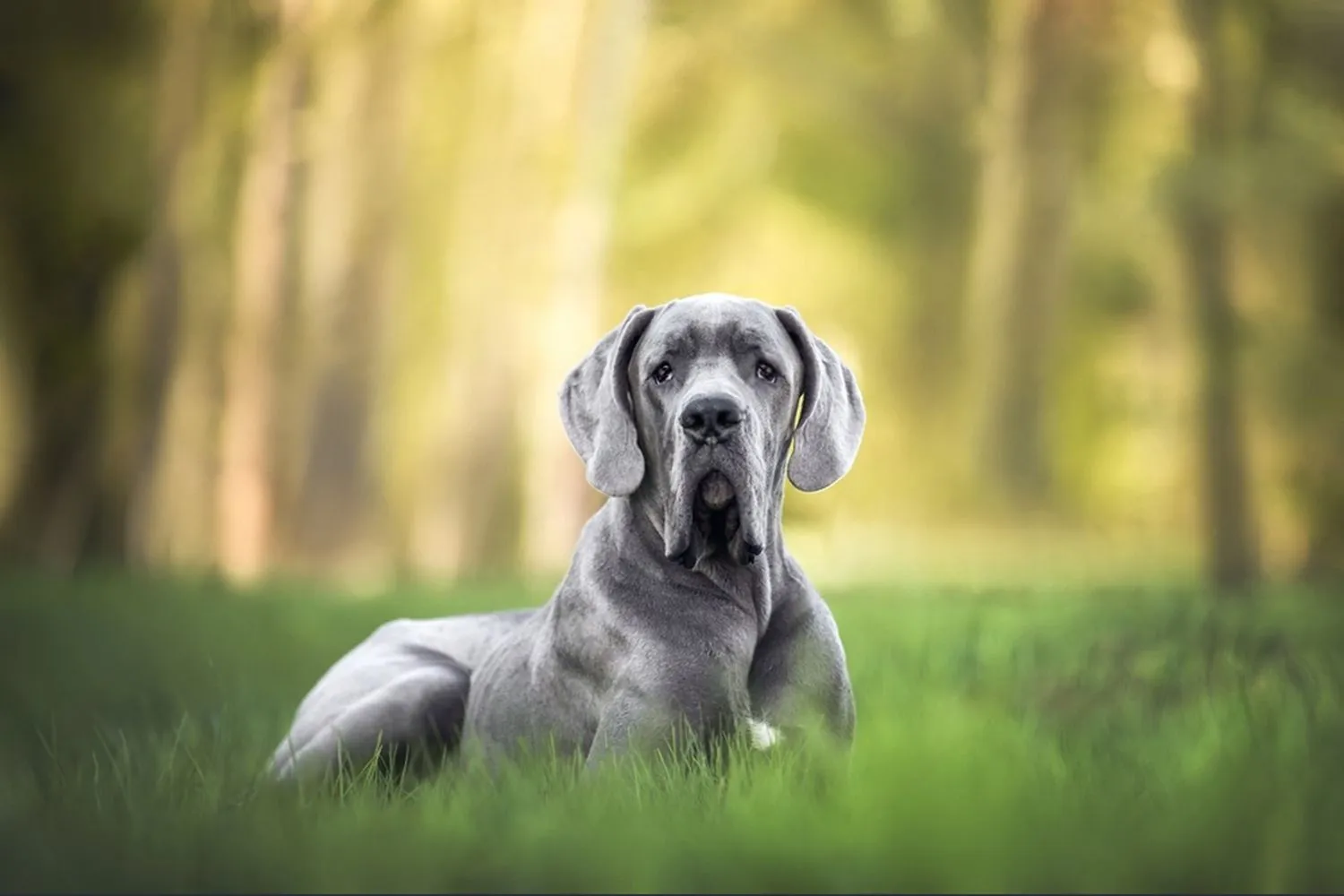
What Is the Lifespan of a Great Dane?
Great Danes are gentle giants, and with that giant size comes a shorter average lifespan typically around 8 to 10 years. In general, smaller dogs tend to stick around longer, while bigger breeds burn bright for a shorter time. It’s a tough trade off for such a lovable, couch hogging companion, but those years are often packed with big love and bigger personality. I still smile thinking about my friend’s Dane, Luna, who would sit on your lap like a 150-pound cat and lean her whole heart into you. She made it to 11 with careful care and a lot of naps in sunny spots.
How long your Great Dane lives can vary based on genetics, diet, exercise, and everyday care. Keeping them at a healthy weight is huge extra pounds are rough on joints and the heart. I like to use the “you should feel the ribs but not see them” rule and measure meals instead of free feeding. For puppies, slow and steady growth is the goal; your vet can help you choose a large breed formula so those big bones and joints develop properly. Regular, low impact exercise like brisk walks and play sessions on grass help keep muscles strong without overloading their frame. My old foster Dane, Moose, adored morning walks and then snoozed like a champion the rest of the day.
Routine vet visits are your best friend. I do yearly checkups for youngsters and switch to twice a year once they hit middle age, just to catch things early. Danes can be prone to joint issues, heart problems like dilated cardiomyopathy, and bloat. I feed smaller, more frequent meals and avoid hard exercise right before and after eating. If you’re curious, ask your vet about a preventive gastropexy during a spay/neuter it’s a conversation worth having for peace of mind. Little comforts matter too: an orthopedic bed, rugs for traction on slippery floors, and keeping nails trimmed make a big difference for those long legs.
Most of all, make their time rich. Short training sessions keep their brains busy, and gentle socialization helps them stay confident and calm. I keep a “joy list” for my dogs favorite park, best cuddle blanket, special chew and make sure we check items off often. Great Danes may not be with us as long as we’d like, but with thoughtful care, good food, regular vet checks, and plenty of love, those 8 to 10 years can feel wonderfully full.
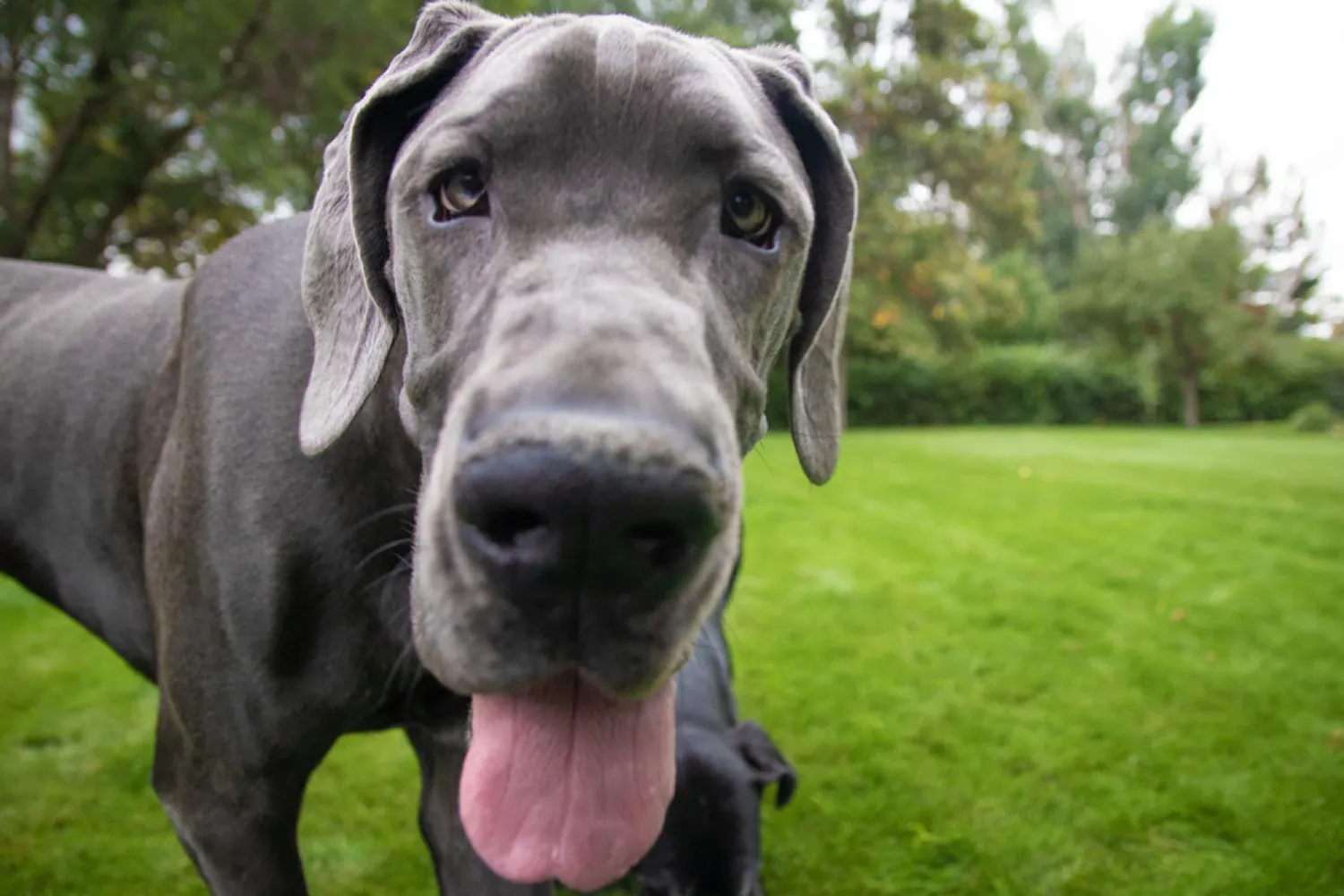
How Much Should a Great Dane Eat?
Great Danes are lovable giants, and yes, they can go through a shocking amount of dog food. I remember the first time my friend’s Dane, Moose, came over his food scoop looked like a snow shovel compared to my little dog’s tiny cup. But it’s not just about volume. The first two years are crucial for bone and muscle development, so the quality and balance of what goes into that big bowl really matter.
For puppies, skip regular puppy food. Giant breed puppies need formulas designed specifically for slow, steady growth with the right balance of protein, fat, and minerals. I like to look for foods that are clearly labeled for large or giant breeds and meet recognized nutritional standards. When in doubt, I snap a photo of the label and run it by my vet. They’ll help you figure out not only which brand is a good fit, but also how much and how often to feed as your pup grows.
Day to day, I measure meals instead of free feeding and adjust based on how the dog looks and feels. You should be able to feel ribs with a light touch, see a slight waist from above, and notice a tuck at the belly from the side. Many Dane owners split meals into smaller servings throughout the day especially for puppies and keep things calm before and after meals. Slow feeder bowls can help enthusiastic eaters take their time. Don’t forget to count treats in the daily total, and keep growth steady rather than chubby. And because big dogs mean big bags, I buy food in manageable quantities and store it airtight to keep it fresh.
Every Great Dane is a little different, so partner with your vet to create a feeding plan that matches your dog’s age, activity level, and growth. It’s one of the best investments you can make in those long legs and that big, goofy heart.
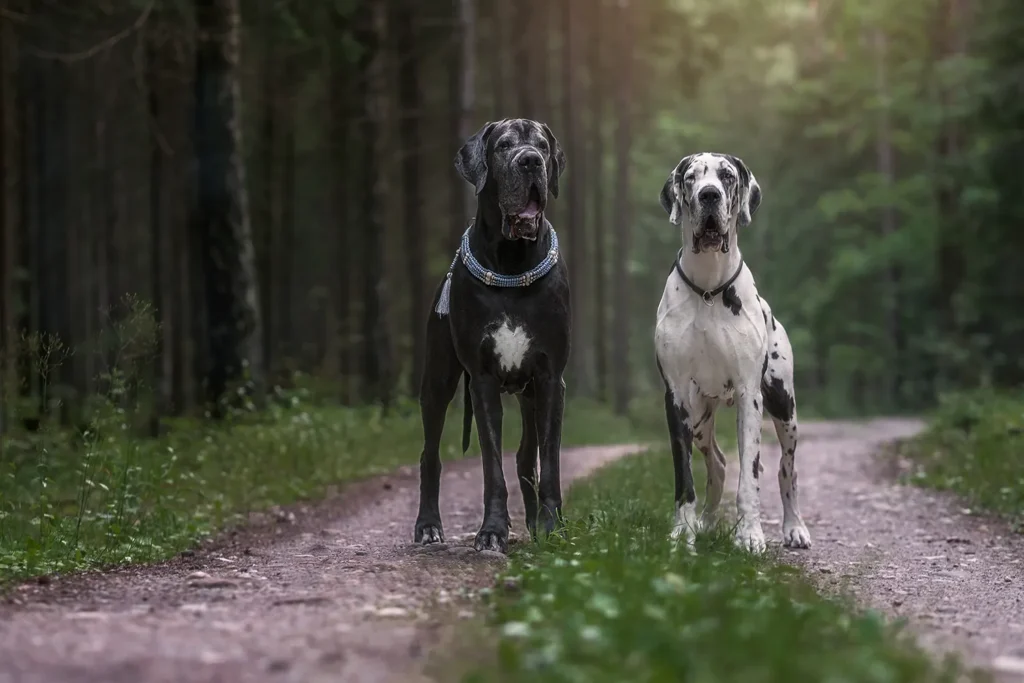
Great Dane FAQs
I’ve met a lot of Great Danes over the years, and yes – the “gentle giant” reputation is well earned. They’re big softies who tend to bond deeply with their people. I’ll never forget the first time a Dane leaned all his weight against my legs, like a living weighted blanket. With that tenderness comes a need for good guidance, though. Your pup’s manners will reflect the training and boundaries you set from day one. A friendly nudge from a 20-pound puppy is adorable; the same move at 140 pounds can bowl Grandma over. Start early, stay consistent, and you’ll have a loving, loyal shadow who knows how to be polite in a big body.
Are Great Danes responsive to obedience training?
Absolutely. Danes are smart, eager to please, and usually pick up cues quickly. Obedience isn’t just a nice extra with this breed – it’s a must have. Think loose leash walking, “sit,” “stay,” and especially “leave it” and “off.” I made “four on the floor” a house rule after a young Dane I was dog sitting tried greeting neighbors by standing up to say hello. Cute at first, but at full size? Not so much. Short, upbeat training sessions work best, and they’re perfectly suitable even for first time owners who are ready to be consistent and patient. If something feels off or you’re struggling, don’t wait it out – get help from a positive reinforcement trainer. With a dog this large, unwanted habits can become safety issues fast.
Do Great Dane puppies require more than two walks a day?
Plan on around two hours of daily exercise for a Great Dane, but spread it out and tailor it to your dog. I like to break it into several shorter walks and play sessions – it helps with toilet training, prevents boredom, and keeps the wiggles in check. For puppies, keep sessions gentle and frequent, with lots of sniffing breaks and time to rest in between. Dane pups grow fast, so think low impact: easy strolls, training games, and brain work like scent games or puzzle feeders. On hot days or when they’re feeling lazy (and yes, these giants can be world-class couch potatoes), swap a longer hike for a few shorter sniffaris and some indoor enrichment. You’ll learn your dog’s rhythm quickly; some need every minute of that two hour guideline, while others are content with moderate exercise and a good nap.
Where can I find a Great Dane puppy breeder?
Finding an ethical breeder is essential – for your future dog’s health and for your peace of mind. You don’t want to unintentionally support puppy farming, which is both unethical and a common source of health and temperament problems. Do your homework before you fall in love with a pair of giant paws. Start by contacting your local Great Dane Club and the National Breed Club; they can point you toward reputable breeders. Ask for all relevant documentation, and don’t be shy about questions. A good breeder will expect them and have plenty for you, too.
When you visit, you should be able to meet at least the mother, see where the puppies are raised, and look over health records. Ask about health testing appropriate for the breed, early socialization, and what support they offer after you bring your puppy home. I once drove three hours to meet a breeder who had a neat folder of certifications ready and a mellow, sofa sized sire who wandered over, sighed, and fell asleep on my feet – that was the confidence I needed. Be cautious of “too good to be true” prices or breeders who won’t let you visit, push multiple breeds, or dodge questions about paperwork. Cheaper upfront can mean costly problems later, from not being purebred to inherited health issues.
Living with a Great Dane means bigger everything – beds, bowls, and heart. With thoughtful training, sensible exercise, and a careful start with the right breeder, you’ll have a gentle giant who fills your home with love (and probably your couch, too).
Disclaimer:
This article is for informational purposes only and doesn’t replace professional veterinary or training advice. Always consult a certified vet or dog trainer for guidance specific to your pup.
